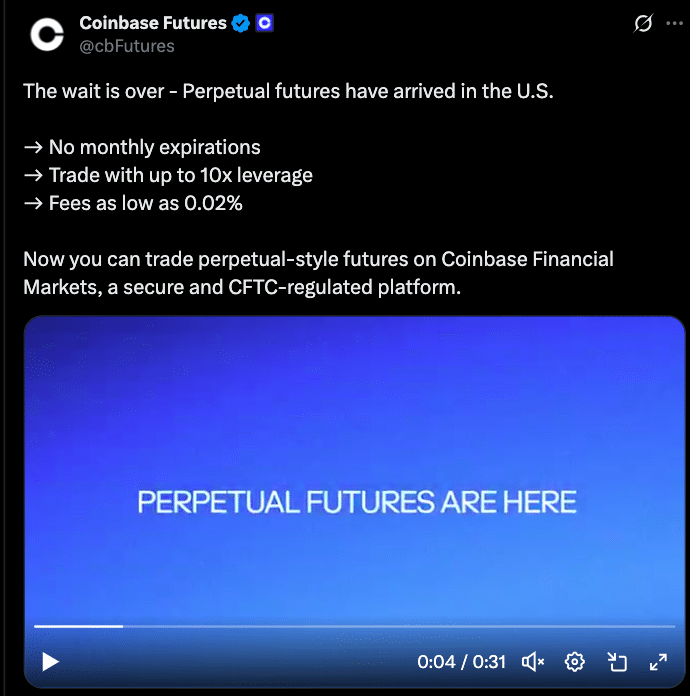According to news sources, Coinbase has launched Coinbase perpetual futures for U.S. users, with two new nano-sized derivative contracts: BTC-PERP and ETH-PERP; available on Coinbase Financial Markets .
- What are Perpetual Futures?
- Regulation Paves the Way
- Key Features & Risks
- What Does This Mean for U.S. Crypto?
- Conclusion
- FAQs
- What are perpetual futures?
- What leverage do BTC-PERP and ETH-PERP offer?
- Are these futures regulated?
- How do nano contracts differ from standard futures?
- What are the risks of perpetuals?
- Glossary
After months of regulatory back-and-forth and a wave of positive policy changes around crypto, including a recent stablecoin bill, eligible U.S. account holders can now trade perpetuals with up to 10× leverage within a regulated framework.
What are Perpetual Futures?
Perpetual futures don’t expire like traditional monthly or quarterly futures contracts. Instead, they use a funding mechanism to keep contract prices in line with spot prices. These are 90% of crypto derivatives volume globally.
On Coinbase, BTC-PERP and ETH-PERP offer nano-scale exposure, perfect for risk-conscious traders who want to get in on the action without full contract size. The platform charges competitive fees as low as 0.02% so it’s open to retail and institutional traders alike.

Regulation Paves the Way
The introduction of Coinbase perpetual futures to the U.S. is a result of the changing regulatory terrain. Earlier restrictions have been relaxed following the CFTC’s approval and clarity around stablecoins and digital assets.
As Coinbase stated on X,
“The wait is over – Perpetual futures have arrived in the U.S.”
Now U.S. users can trade in a CFTC-regulated environment, just like international markets have been doing for years.
Key Features & Risks
The new contracts offer: Perpetual Contracts, that is, No expiration dates, up to 5-year term. It also offers Leverage, that is, trading with up to 10× leverage.
The contract offers Low Fees starting from 0.02%. It is also CFTC monitored, enhancing legal compliance and security.
However, leveraged trading carries its own risk. Small price movements can lead to big losses or liquidation for over-leveraged positions. Coinbase emphasizes the need for users to fully understand the risks before trading perpetuals.
What Does This Mean for U.S. Crypto?
The Coinbase perpetual futures is a big deal for U.S. crypto infrastructure. Perpetuals are reportedly 90% of crypto derivatives volume globally so this brings domestic crypto trading more in line with international markets. It also increases the chances other U.S. exchanges will offer similar products.

From a market dynamics perspective, regulated perpetual futures should improve liquidity, enable better hedging and attract advanced traders who were previously on offshore platforms. It also gives institutional players a compliant way to go long/short in BTC and ETH.
Conclusion
Based on the latest research, the latest Coinbase perpetual futures launch could turn things around for U.S. regulated crypto derivatives. For years, American traders have gone to offshore platforms like Binance or Bybit for perpetual futures. Now, with Coinbase entering the fray under CFTC oversight, retail and institutional users have a domestic, compliant option.
This may not only boost Coinbase’s revenue but also bring liquidity back to the U.S. market. But traders must be careful, especially with leverage.
For in-depth analysis and the latest trends in the crypto space, our team offers expert content regularly.
Summary
Coinbase has launched CFTC-regulated Bitcoin and Ethereum perpetual futures in the U.S., with nano-contracts up to 10× leverage, low fees and no expiration. This closes the gap between U.S. and international crypto markets as perpetuals dominate global derivatives volume. The product is enabled by recent regulatory reforms and stablecoin legislation.
FAQs
What are perpetual futures?
Perpetual futures are derivative contracts with no expiration, using periodic funding rates to match the spot market. They allow for continuous leveraged exposure.
What leverage do BTC-PERP and ETH-PERP offer?
Up to 10× leverage; so users can get amplified exposure with smaller capital outlays.
Are these futures regulated?
Yes. Coinbase perpetual futures are CFTC-regulated, so users have a compliant trading environment.
How do nano contracts differ from standard futures?
Nano contracts are fractional exposure, so users can get in with less capital and manageable position sizes.
What are the risks of perpetuals?
High volatility and leverage; can lead to rapid loss of capital or margin calls.
Glossary
Perpetual Futures: Futures with no expiration; featuring continuous funding to track the market.
Leverage: Trading with borrowed capital to increase gains or losses.
Nano Contracts: Fractional futures contracts allowing smaller position sizes.
Funding: Fee exchanged between traders to incentivize price alignment of futures contracts with spot prices.



















































































































